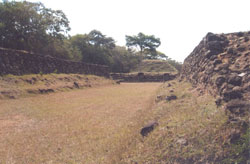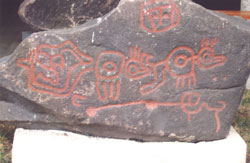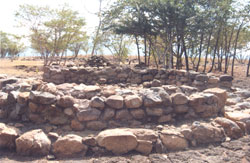El Salvador’s pre-Columbian past
by Julie Skurdenis (Second of two parts)
Early in our January ’09 trip to El Salvador, my husband, Paul, and I visited four of the country’s major archaeological sites: Joya de Cerén, San Andrés, Tazumal and Casa Blanca. We saved Cihuatán for last.
Cihuatán is special in many ways. It is El Salvador’s largest archaeological site, spreading over an area of more than one square mile. Excavation is currently in progress and, from everything we heard, Cihuatán is destined to become the country’s premier archaeological site, combining preservation of the past with recreational and tourist facilities.
But what makes Cihuatán historically exceptional is that it rose to prominence when all else was disintegrating. Maya civilization and its great cities collapsed around AD 900 as a result of overpopulation, top-heavy bureaucracy, exhausted resources and warfare — any or all of these; the debate continues.
Post-Classic Cihuatán
Between AD 900 and 1000, Cihuatán was founded in a river valley in what is now north-central El Salvador. No one knows who founded the city, perhaps migrants from Mexico who became the ancestors of the Pipils occupying much of El Salvador when the Spanish arrived in 1524; perhaps local ethnic groups who banded together for mutual protection, perhaps migrants from elsewhere in Central America.
Whoever these people were, they built a city with two ceremonial centers — and possibly minor centers nearby — with pyramids, temples, palaces and ball courts. This period of growth was brief, only 150 to 250 years, until Cihuatán was suddenly extinguished in a cataclysmic fire around AD 1150. No one knows who destroyed the city or why. It was never rebuilt.
Archaeological trail
What remains is impressive. Visitors can follow a trail with 13 “stops” that leads to all the major excavated sites in the Western Ceremonial Center. These include the stone defense wall that once enclosed the Great Plaza and its structures. This alone makes Cihuatán unique, since there are few walled sites in El Salvador.
There are also two ball courts, one partially excavated (the Western Ball Court) and one completely excavated and partially restored (the Northern Ball Court), with an adjoining temazcal, a room for bathing and for therapy for the hard knocks suffered during the games in the ball court. This temazcal is another unique feature at Cihuatán.
From the Northern Ball Court there’s a great view of the Main Pyramid, which can be climbed via a protective staircase that doesn’t damage the structure. From the summit, on which once stood a temple, there’s a panoramic view over the whole complex, including the Eastern Ceremonial Center where archaeologists are currently excavating what is probably an enormous royal palace.
In the Great Plaza on the way back from the Main Pyramid to the entrance is yet another unique feature, the ruins of a circular stone building that may have been a temple to the god of the winds. Circular structures are rare in Mesoamerica. Only four are known in all of El Salvador.
Cihuatán is located 25 miles north of San Salvador, about an hour’s drive. It’s open 9 to 4, Tuesday to Sunday. Admission costs $3. Trail booklets in English cost $1. Allow at least 60 to 90 minutes to see everything.
Colonial Suchitoto
We visited Cihuatán from the wonderful little colonial town of Suchitoto, 15 miles southeast (Suchitoto is 25 miles northeast of San Salvador).
There are three reasons to go to Suchitoto: to stroll its charming cobblestone streets; to eat at La Fonda del Mirador, with its fantastic view over Lake Suchitoto, and to stay at Los Almendros de San Lorenzo (4a Calle Poniente, Suchitoto, El Salvador; phone 503 2335 1200, e-mail plebailly@hotelsalvador.com).
Los Almendros is a 200-year-old hacienda impeccably restored and converted into a small hotel. It was hard to tear ourselves away from its tropical gardens and gurgling fountains, not to mention our suite with its own lion-headed wall fountain that we could turn on and off with the flick of a switch.
Room rates start at $100 per night, including breakfast; the Lion Suite cost us $142. Staying there at least one night is good; two nights is better, and three, as we did, is best.
San Salvador sights
Although we concentrated on visiting archaeological sites on this trip, we found plenty to do in San Salvador during our nine days there.
First and foremost was the David Guzmán National Museum of Anthropology with its mix of folk art and archaeological artifacts, including huge boulders with incised petroglyphs and an altar from Quelepa in eastern El Salvador, the only one of the country’s six major archaeological sites we didn’t get to visit.
There are three other don’t-miss museums: the fascinating Museum of Popular Art, displaying tiny clay figurines called sorpresas; the Museum of Modern Art, highlighting Salvadoran artists (although there are temporary exhibitions of foreign artists as well (we saw a superb Miró exhibit on our visit), and the Fernando Llort Museum, devoted to the works of this contemporary artist who paints and does ceramics in bright, vibrant colors.
San Salvador’s downtown area is chaotic and noisy, but this is where the Cathedral is located with the tomb of Archbishop Oscar Romero, assassinated in 1980, and the very unusual church (picture an airplane hangar or an old factory) of El Rosario on Parque Libertad with its winged statue of Liberty. The stained glass inside is simple and stunning.
Prowling the malls
We also did something which for us is exotic: went to three shopping malls in nine days. Exotic for us because we haven’t been to three malls in nine years at home in New York.
Many of San Salvador’s malls are upscale, glittery and air-conditioned, with some good handicraft shops and great cafés in which to sample Salvadoran coffee. If you don’t “do” malls at home, try a few in San Salvador. We chose upscale Gran Via, more down-to-earth MultiPlaza and overwhelming Metrocentro, supposedly the largest mall in Central America.
Another “do not miss” is the Ruta de las Flores, a mountain road that starts at Sonsonate west of San Salvador and winds its way 24 miles through the picturesque villages of Izalco, Nahuizalco, Juayua, Apaneca and Ataco. There are coffee plantations and charming places to dine along the route. It’s a great day excursion from San Salvador.
If you go. . .
We flew to San Salvador from New York nonstop on TACA (800/535-8780), a flight of about five hours — very comfortable business class.
For most of our 12-day stay in El Salvador, we based ourselves in San Salvador at the Hilton Princess Hotel (phone 011 503 268 4545 or, in the US, 800/445-8667), which is in a good location at Avenida las Magnolias and Boulevard del Hipodromo. There were lots of restaurants nearby, including Shaw’s, a café/sweet shop/bookstore right next door to the hotel.
Nightly room rates at the Hilton start at $79, not including the 18% tax. Our Executive Suite with bedroom, separate living room, two bathrooms and use of the Executive Lounge with all its amenities cost us $149 plus 18% tax.



